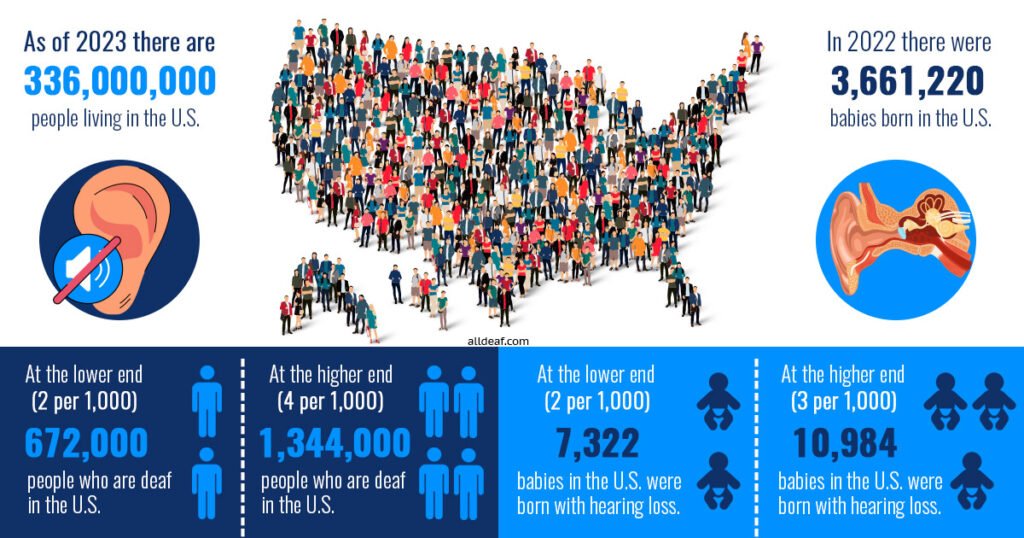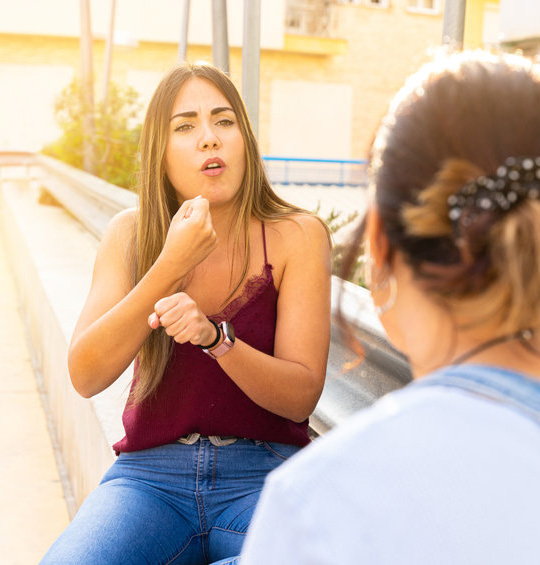When someone says he or she’s “deaf”, or a periodical mentions people being “functionally deaf”, it usually means that the person has little to no hearing at all. We say “usually”, because there are hard-of-hearing people that prefer to be identified as deaf people yet in most cases, they can speak and hear a little with or without the help of hearing aids.

How Do People Become Deaf?
Deafness can occur at any age for reasons known or unknown. It is estimated that 2 or 3 out of every 1,000 children are born deaf or have some type of hearing loss. Believe it or not, more than 90 percent of deaf babies are born to hearing parents, not deaf parents (more on that below).
The most common causes of hearing loss, which can range from mild to profound, are:
- Genetics accounts for about 50% of all cases of hearing loss in babies, according to Centers for Disease Control and Prevention (CDC).
- A high fever of over 104 degrees can damage the cochlea in the ear and cause hearing loss.
- Medication such as taking large doses of aspirin can damage the ears and cause deafness.
- Exposure to extremely loud sounds, such as being close to gunfire and explosions, can rupture the eardrums and cause permanent hearing loss.
Other Types of Deafness
- Conductive Hearing Loss is caused by something that stops sound waves from going through your inner ear. This is commonly caused by an ear infection or fluid in the middle ear from a cold, which can be treated with medicine.
Do Deaf People Have Deaf Children?
Not necessarily. In fact, it’s actually rare for deaf parents to have deaf children. Hearing parents, on the other hand, are more likely to have deaf children. Statistics show that the chances of deaf parents having deaf children are around 10%, while the chances for hearing parents having deaf children are around 90%.
A hearing child whose parents are deaf is considered a CODA. They grow up being bilingual and are fluent in spoken language, and typically fluent in sign language as well. Because of this, CODAs can naturally act as informal sign language interpreters for their deaf parents in various settings, such as parent-teacher meetings and doctor’s appointments. They also share a cultural connection with the Deaf community.
Do Deaf People Have Tinnitus?
If we’re talking about people with profound hearing loss (completely deaf), then it’s rare for them to experience tinnitus. The ringing in the ears typically affects those with mild, moderate, or severe hearing loss. People of all ages can be affected by tinnitus in one or both ears.
Do Deaf People Read Lips?
The truth is, most deaf people can’t read lips. There’s only a small percentage of deaf people, at least in the United States, who have the ability to lip read. This is assuming that the person they’re trying to lip-read doesn’t have a mustache/beard, which would make it extremely difficult to read.
The deaf people that can read lips well are those with fluency in English, have received oral and speech training, and/or were mainstreamed in schools while growing up. This type of oral program and speech training was pretty common in schools back in the 1970s and 1980s, but not so much these days. It also explains why some deaf people can’t talk while others can.
Because not every deaf person can afford their own personal sign language interpreter, lip-reading can be beneficial to them for common everyday situations, such as going shopping, ordering food, and dealing with the bank teller, among other interactions.
In the United States, businesses and organizations are required by the Americans with Disabilities Act (ADA) to hire sign language interpreters when communicating with their deaf or hard of hearing employees, clients, and patients. This ensures that the Deaf have equal access to important information and services, whether in the workplace, at a doctor’s appointment, or during legal proceedings. Just as lip-reading isn’t an option for many deaf people, relying on written notes and/or body language can lead to misunderstandings and potential lawsuits.
Deaf Technology & Products
Since the majority of deaf people can’t hear sounds, including speech, they heavily rely on visual, vibration, and hearing technologies.
Visual products include strobe alarm clocks, doorbell lights, flashing alarm clocks, and baby monitors.
Vibrating products include deaf alarm clocks to help deaf people wake up, vibrating watches, and even vibrating vests to allow deaf people to feel music.
Hearing technologies include hearing aids and cochlear implants to help them “hear.” It’s pretty common to see deaf people not wearing hearing instruments because they feel as though they don’t really need them. Hard-of-hearing people, on the other hand, typically rely on hearing aids on a daily basis so it’s almost always a must-have.
There are also car technologies that help deaf people drive safely on the roads.
Deaf Emergency Services
When there’s an emergency, deaf people call 911 by texting ‘911’ on their phones, that way, they’ll be able to text message the call centers. They can also use a TTY or a relay service, but those are time-consuming. If text-to-911 is not available to the deaf and hard of hearing in their state, it is encouraged that they use telecommunications relay services instead.
Can A Deaf Person Hear With A Hearing Aid?
Whether a deaf person can hear with a hearing aid depends on the severity of their hearing loss. A hearing aid typically works by making sounds louder, so someone with profound hearing loss may be able to hear something but still struggle to recognize spoken words.
An example would be if you call out a deaf person’s name, he won’t be able to hear you right away, so you raise your voice and try again. Only this time he thinks he heard something so he looks around, only to realize it was you all along. But once you try to say something to him, he won’t be able to hear and understand your spoken words.
A better way to get a deaf person’s attention is to wave at them while calling their name, and when they turn around and face you, talk slowly and use body language when communicating. If they still don’t understand you, then use a paper and pen and write things down for them to read.
There’s a misconception that hearing aids, or even cochlear implants, will cure hearing loss and that a deaf person will be able to hear and talk again after wearing them. That’s just not true at all.
Hearing aids are more beneficial for people with mild, moderate, and almost severe hearing loss. And for those with severe to profound hearing loss, a cochlear implant is almost always recommended these days by audiologists and hearing specialists, since wearing a hearing aid(s) won’t do much for them.
There are different types of hearing aids available on the market today, like receiver-in-the-ear (RIC), behind-the-ear (BTE), and others, but when it comes to hearing aid technologies, there are only two options: analog or digital hearing aids.
Can Deaf People Hear With A Cochlear Implant?
Topics on cochlear implants, and the surgery itself, are controversial. Cochlear implants are often misrepresented as being a miracle cure for someone who is deaf and signs. You will notice someone who has a cochlear implant by having a black or grey magnet piece next to their ear, then a wire that connects to the processing unit that sits behind the same ear. The processing unit (that looks like a hearing aid) has an LED indicator light that blinks green (turning/turned on) or amber (turning/turned off).
There are both advantages and disadvantages to getting a cochlear implant. Children, teens, and young adults who are completely deaf are the ideal candidates for the medical company Cochlear Limited, and it makes sense. Children learn to speak through listening, so the younger they are (9 months or older), the better. So, if they have severe hearing loss that cannot be helped with hearing aids, then a cochlear implant should do the trick by bypassing the damaged ear and directly working the hearing nerves.
However, there are risks to consider if one is thinking about getting a cochlear implant for themselves or their children. Here are the most common ones:
- Anesthesia has to be performed since an external part has to be surgically placed under the skin of the head. Even though the doctors may tell you that the risk of anesthesia is very low, it’s more of a personal decision if the risk is worth it or not, especially when we’re talking about babies and children here.
- CT scan radiation exposure has been linked to an increase in developing a fatal brain tumor later in life, especially for children. CT scans are “necessary” (according to the doctors) to see if the candidate’s cochlea is in good shape before they can get a cochlear implant. If you’re thinking of getting it for yourself or your child, try to opt for an MRI, X-ray, or other tests that use little to no radiation.
- Any remaining hearing is destroyed in most cases after getting a cochlear implant. If one had very little hearing left before the surgery, they lose the chance of any future inner or outer hearing technologies.
- Facial nerve injury can happen if there’s nerve damage to the inner ear while performing the cochlear implant surgery. As a result, there will be droopiness, weakness, and loss of facial movement on one side of the face. This is also known as facial paralysis.
- Meningitis is a bacterial infection of the membranes that protect the brain and spinal cord, and people with cochlear implants have a higher risk of getting this disease. There’s a vaccination that the CDC recommends getting for those who have or are considering getting cochlear implants.
- Dizziness, vertigo, and headaches are typically reported by those with cochlear implants. As a matter of fact, it is not uncommon to see people not wearing their cochlear implants and just ditching them altogether due to experiencing dizziness and headaches.
Sign Language vs ASL
The primary language most commonly used by deaf and hard of hearing people is sign language. Like spoken language, each country may have its own version of sign language. For instance, in North America, deaf people use American Sign Language, or ASL for short. There are somewhere around 300 different sign languages around the world. Below are a few examples:
- British Sign Language (BSL)
- Chinese Sign Language (CSL or ZGS)
- French Sign Language (LSF)
- Spanish Sign Language (LSE)
It’s interesting to note that American Sign Language was invented by intermixing local sign language and French Sign Language at the American School for the Deaf (ASD) some 200 years ago. In case you didn’t know, ASD was founded by Thomas Gallaudet, an educator for the deaf, and Gallaudet University is named after him.
Due to their use of sign language on a regular basis, deaf people tend to think in ASL, words, or pictures. They don’t hear their own thoughts in the way a hearing person typically might. Hard of hearing people may think in terms of lip reading or even in their own voice.
How Many Deaf People in the US?
As of 2023, there are currently 336 million people living in the U.S., and about 2-4 of every 1,000 people are “functionally deaf”, with the majority of them being 65 years or older. Let’s do some math.
At the lower end (2 per 1,000):
336,000,000 / 1,000 * 2 = 672,000 people in the U.S. who are deaf.
At the higher end (4 per 1,000):
336,000,000 / 1,000 * 4 = 1,344,000 people in the U.S. who are deaf.
There were about 3,661,220 babies born in the U.S. in 2022, and about 2-3 of every 1,000 babies were born with hearing loss.
At the lower end (2 per 1,000), 7,322 babies in the U.S. were born with hearing loss.
At the higher end (3 per 1,000), 10,984 babies in the U.S. were born with hearing loss.
Keep in mind that only a small number of newborns who fail a hearing screen test will have permanent hearing loss. Middle ear fluid is the most common cause of failed newborn hearing tests. In most cases, the fluid in the ears will go away on its own within the first few months after the baby is born.

How Many Deaf People in the World?
According to the WHO, there are 1.5 billion people around the world who have hearing loss, with more than 1 billion young people (12-35 years of age) who are at risk due to repeated non-occupational loud noises (fireworks, concerts, loud music, ear/headphones, etc).
About 980 billion dollars are spent each year due to people’s hearing loss not being taken care of or properly treated. This includes direct medical costs like audiology and ENT visits, hearing aids and cochlear implants, and other ear surgeries and treatments. It also includes indirect costs such as loss of productivity when deaf people can’t work as effectively as those with normal hearing.
Deaf communities around the world who share a common language, life experiences, and values are bonded by deaf culture. A deaf community can include ASL interpreters, the hard of hearing, and family members of Deaf people.
Every year in September, deaf, hard-of-hearing, and hearing people from all over the world come together to celebrate their unique cultures, languages, and experiences. Deaf Awareness Month is a month dedicated to raising public awareness of the communication needs and other issues, as well as support, of deaf and hard of hearing people.
What To Do If My Baby Is Born Deaf?
Immediately start signing to your baby, don’t wait. If you’re a hearing parent and don’t know sign language, it’s never too late to start learning ASL. You want to be able to communicate with your deaf child.
And as they grow older, always try to actively include them in conversations you have with other people. You don’t want your child to grow up feeling neglected, excluded, or socially isolated due to not being able to hear or understand spoken language. So, as a hearing parent to a deaf child, we encourage you to:
- Repeat what was said during a conversation in sign language
- Sign and ask what they think about the conversation you had, get them involved.
- Always look directly at them when you’re signing.
- Do what’s best for your child and love them for who they are. Always.
At some point in your child’s life, they will look back and appreciate the efforts you made to alleviate any communication hurdles or barriers.
Share this post with your friends using these one-click sharing options:
👉 Click here to share on Facebook.
👉 Click here to share on X.
👉 Click here to share on LinkedIn.

Get the latest interviews, tips and guides in your inbox.